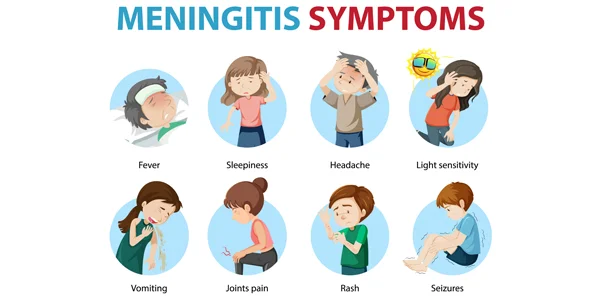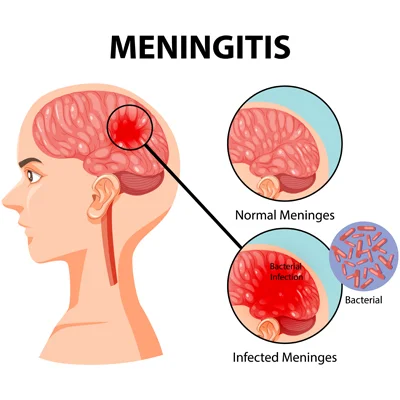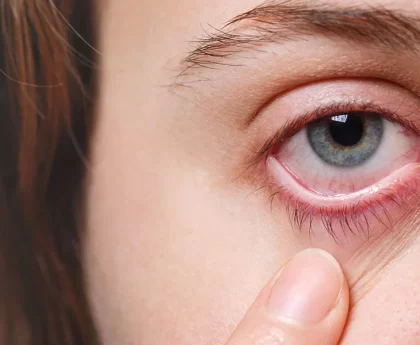Meningitis: Types, Symptoms, Causes & Prevention, is an inflammation of the meninges, which are the protective membranes that cover the brain and spinal cord. These membranes consist of three layers: the pia mater, the arachnoid mater, and the dura mater. Meningitis is typically caused by an infection, most commonly by viruses or bacteria, but it can also result from other factors such as fungi, parasites, or non-infectious conditions.
The condition can lead to a range of symptoms, including severe headaches, fever, neck stiffness, and in some cases, altered mental status and neurological symptoms. Meningitis can be a potentially life-threatening medical emergency, especially if it is caused by certain bacteria. Timely diagnosis and treatment are crucial for a positive outcome. Treatment often involves antibiotics or antiviral medications, depending on the cause of the infection.
There are several different types of meningitis, including viral meningitis, bacterial meningitis, and fungal meningitis, each with varying causes and severity. The specific type and severity of meningitis can significantly impact the course of the disease and the potential long-term effects.
Types of Meningitis
Meningitis can be categorized into several different types based on the cause of the infection.
The most common types of meningitis include:
- Viral Meningitis: This is the most common and often less severe form of meningitis. It is typically caused by various viruses, such as enteroviruses (including coxsackievirus and echovirus), herpes simplex virus, and mumps virus. Viral meningitis tends to be less severe than bacterial meningitis and often resolves on its own with supportive care. It can result in symptoms like fever, headache, neck stiffness, and sensitivity to light.
- Bacterial Meningitis: This is a more severe and potentially life-threatening form of meningitis. It is caused by various bacteria, with the most common culprits being Streptococcus pneumoniae, Neisseria meningitidis (meningococcus), and Haemophilus influenzae type b. Bacterial meningitis requires prompt medical attention and treatment with antibiotics. Symptoms can include severe headache, high fever, neck stiffness, vomiting, and confusion.
- Fungal Meningitis: Fungal meningitis is caused by fungal pathogens, such as Cryptococcus and Candida species. It is relatively rare and tends to affect people with weakened immune systems, such as those with HIV/AIDS or individuals undergoing organ transplant. Fungal meningitis is a chronic condition and often requires long-term antifungal treatment.
- Parasitic Meningitis: This type of meningitis is caused by parasites. One notable example is amebic meningitis, caused by the free-living amoeba Naegleria fowleri, which can enter the brain through the nasal passages and is usually fatal. Another example is eosinophilic meningitis, caused by certain parasitic worms like Angiostrongylus cantonensis.
- Non-Infectious Meningitis: Not all cases of meningitis are caused by infections. Non-infectious meningitis can result from various non-infectious factors, such as autoimmune diseases (e.g., lupus), certain medications, and chemical irritants. It may mimic infectious meningitis symptoms but does not respond to antibiotics.
- Tuberculous Meningitis: This is a specific form of bacterial meningitis caused by the bacterium Mycobacterium tuberculosis, which is the same bacterium that causes tuberculosis (TB). Tuberculous meningitis is a rare but serious complication of TB.
The specific treatment and prognosis for meningitis depend on the type and cause of the infection. Prompt diagnosis and appropriate treatment are essential, especially in cases of bacterial meningitis, as it can progress rapidly and lead to severe complications if not treated promptly.

Symptoms of Meningitis
Meningitis can present with a variety of symptoms, and the severity of these symptoms can vary depending on the type of meningitis (viral, bacterial, fungal, etc.) and the individual’s age and overall health.
Common symptoms of meningitis include:
- Fever: A high body temperature is a typical symptom of meningitis. The fever can develop suddenly and be accompanied by chills.
- Severe Headache: Meningitis often causes a severe, persistent headache. This headache can be one of the most prominent symptoms.
- Stiff Neck: Neck stiffness and pain, also known as nuchal rigidity, are common symptoms. It may be difficult to touch the chin to the chest due to neck stiffness.
- Photophobia: Sensitivity to light is common in people with meningitis. Bright lights or sunlight can be particularly bothersome.
- Vomiting and Nausea: Many individuals with meningitis experience nausea and may vomit.
- Altered Mental Status: Meningitis can cause confusion, irritability, and a decreased level of consciousness. In severe cases, it can lead to coma.
- Seizures: Some individuals may have seizures as a result of meningitis, especially in bacterial meningitis cases.
- Rash (in Bacterial Meningitis): In some cases of bacterial meningitis, a distinctive rash may develop. This rash is often associated with meningococcal meningitis and may appear as small, reddish-purple spots.
- Muscle Aches and Joint Pain: Joint and muscle pain, also known as myalgia and arthralgia, can be present in viral meningitis.
- Fatigue and Weakness: Individuals with meningitis may feel extremely tired and weak.
It’s important to note that the symptoms of meningitis can progress rapidly, and the severity of symptoms may change over a short period of time. In infants and young children, symptoms can be less specific and may include irritability, poor feeding, and a bulging fontanel (the soft spot on an infant’s head). In elderly individuals or those with weakened immune systems, the symptoms may also be less typical.
If someone is suspected of having meningitis, especially if they exhibit severe symptoms or multiple symptoms, it is crucial to seek immediate medical attention. Meningitis can be a life-threatening condition, especially if it is caused by bacteria, so early diagnosis and treatment are critical for a positive outcome.
Causes of Meningitis
Meningitis can be caused by various factors, with the most common cause being infections, primarily viral and bacterial infections.
Here are some of the primary causes of meningitis:
- Viral Infections: Viruses are a common cause of viral meningitis. Several viruses can lead to this type of meningitis, including enteroviruses (such as coxsackieviruses and echoviruses), herpes simplex virus, mumps virus, and others. Viral meningitis is typically less severe than bacterial meningitis and often resolves on its own with supportive care.
- Bacterial Infections: Bacterial infections can cause bacterial meningitis, which is often more severe and potentially life-threatening than viral meningitis. Common bacteria responsible for bacterial meningitis include Streptococcus pneumoniae, Neisseria meningitidis (meningococcus), and Haemophilus influenzae type b. Bacterial meningitis requires prompt medical attention and treatment with antibiotics.
- Fungal Infections: Fungal meningitis is caused by various fungal pathogens, such as Cryptococcus species and Candida species. Fungal meningitis is relatively rare and tends to affect individuals with weakened immune systems, such as those with HIV/AIDS or transplant recipients. It usually requires long-term antifungal treatment.
- Parasitic Infections: Certain parasites can lead to parasitic meningitis, although this is relatively rare. Examples include Naegleria fowleri, a free-living amoeba that can enter the brain through the nasal passages, and Angiostrongylus cantonensis, a parasitic worm.
- Non-Infectious Causes: Meningitis can also result from non-infectious factors, such as autoimmune diseases (e.g., lupus), certain medications, chemical irritants, or underlying medical conditions. This form of meningitis is known as non-infectious or aseptic meningitis.
- Tuberculosis (TB): Tuberculous meningitis is a specific form of bacterial meningitis caused by Mycobacterium tuberculosis, the bacterium responsible for tuberculosis. It occurs when TB bacteria spread to the membranes surrounding the brain and spinal cord.
It’s important to note that the treatment and prognosis for meningitis depend on the underlying cause. Bacterial meningitis, in particular, is a medical emergency and requires immediate treatment with antibiotics. Early diagnosis and treatment are crucial for a positive outcome, as this condition can lead to severe complications if left untreated. In contrast, viral meningitis often resolves without specific treatment, and fungal or parasitic meningitis may require specialized antifungal or antiparasitic medications, respectively. Non-infectious meningitis typically involves treating the underlying condition that led to the inflammation of the meninges.
Prevention of Meningitis
Preventing meningitis often involves various strategies depending on the underlying cause.
Here are some general and specific measures for preventing meningitis:
- Vaccination:
– Bacterial Meningitis: Vaccines are available to protect against some of the common bacteria that can cause bacterial meningitis. These vaccines include the Haemophilus influenzae type b (Hib) vaccine, the pneumococcal conjugate vaccine, and the meningococcal vaccines (A, C, W, Y and B types). Routine childhood and adolescent immunizations include these vaccines. Meningococcal vaccines are particularly important for college students living in close quarters.
– Viral Meningitis: There are vaccines available to prevent some viral infections that can lead to viral meningitis, such as the measles, mumps, rubella (MMR) vaccine and the varicella (chickenpox) vaccine. - Good Hygiene:
– Practicing good hygiene can help reduce the risk of infection, which is often a cause of viral and some bacterial forms of meningitis. This includes regular handwashing with soap and water, avoiding close contact with individuals who are sick, and covering your mouth and nose when sneezing or coughing. - Avoiding Sharing Personal Items:
– Refrain from sharing items like drinking glasses, eating utensils, or other personal items that can potentially transmit infections. - Maintaining a Healthy Lifestyle:
– A strong immune system can help your body fight off infections. Maintain a healthy lifestyle through regular exercise, a balanced diet, adequate sleep, and managing stress. - Protecting Against Insect Bites:
– Certain parasitic infections that can cause parasitic meningitis are transmitted by insect vectors. If you live in or travel to areas with these parasites, take precautions to prevent insect bites. Use insect repellents and wear protective clothing, such as long sleeves and pants. - Reducing Risks for Tuberculous Meningitis:
– Tuberculous meningitis is caused by Mycobacterium tuberculosis, which also causes tuberculosis (TB). Reducing the risk of TB infection can help prevent tuberculous meningitis. This includes getting tested for TB if you’re at risk, taking medications as prescribed if you have latent TB infection, and avoiding close contact with individuals who have active TB disease. - Treating Underlying Medical Conditions:
– Some cases of non-infectious meningitis may be linked to autoimmune diseases or other medical conditions. Proper management and treatment of these underlying conditions can reduce the risk of meningitis.
It’s important to note that while these preventive measures can reduce the risk of meningitis, they may not completely eliminate the possibility of the disease. Additionally, the appropriate preventive strategies can vary based on the specific type and cause of meningitis. If you have specific concerns or questions about meningitis prevention, consult with a healthcare professional for personalized guidance.

Is meningitis a lifetime?
Meningitis itself is not typically a lifelong condition. Meningitis refers to the inflammation of the meninges, which are the protective membranes that cover the brain and spinal cord. Meningitis can be caused by various factors, most commonly infections (e.g., viral or bacterial), and it often represents an acute or subacute illness.
The duration and severity of meningitis can vary depending on its underlying cause and how quickly it is diagnosed and treated. In many cases, viral meningitis is a self-limiting condition, and individuals can recover fully with appropriate care and supportive treatment.
Bacterial meningitis, on the other hand, is more severe and requires immediate medical attention. Timely treatment with antibiotics is essential to prevent serious complications, but even with treatment, bacterial meningitis can still have long-term effects for some individuals, such as hearing loss, cognitive impairments, or neurological deficits.
Other forms of meningitis, such as fungal or parasitic meningitis, tend to be chronic conditions that may require ongoing or long-term treatment. These forms of meningitis are relatively rare and often occur in individuals with specific risk factors, such as immunosuppression.
Non-infectious meningitis may result from underlying medical conditions, medication side effects, or other non-infectious factors. The duration and impact of non-infectious meningitis will depend on the underlying cause and how it is managed or treated.
In summary, meningitis itself is not typically a lifelong condition, but the long-term outcomes can vary widely depending on the type, cause, and individual factors. If you or someone you know has had meningitis, the prognosis and potential long-term effects should be discussed with a healthcare provider who can provide personalized information and guidance.
How long can meningitis live on clothes?
Meningitis, specifically bacterial or viral meningitis, is primarily a disease that affects the central nervous system and is not typically associated with the ability to survive on inanimate objects like clothing for extended periods. The transmission of meningitis usually occurs through respiratory secretions, such as saliva or mucus, and through close personal contact with an infected person. The bacteria or viruses that cause meningitis are not known to survive for extended periods outside the human body on surfaces like clothing.
That said, it’s always a good practice to maintain proper hygiene and cleanliness, including regularly washing your clothes, especially if you’ve been in close contact with someone who has been diagnosed with bacterial meningitis. Proper washing and disinfecting of clothing can help reduce the risk of spreading the infection, although the primary mode of transmission is person-to-person contact.
In general, following good hygiene practices, such as regular handwashing, covering your mouth and nose when sneezing or coughing, and avoiding close contact with someone who is sick, is more important for preventing the spread of meningitis than concerns about the persistence of the bacteria or virus on clothing.
Foodborne Diseases: Types, Symptoms, Causes & Prevention
Irritable Bowel Syndrome: Types, Symptoms, Causes & Prevention
Breast Cancer: Types, Symptoms, Causes, & Prevention
Migraine: Types, Symptoms, Causes & Home Remedies
Understanding Syncope: Symptoms, Causes & Home Remedies
Freckle: Symptoms, Causes, Prevention & Need to Know
Dehydration: Symptoms, Causes, & You Should Know About
Stress: Symptoms, Causes & Prevention
Snoring: Types, Symptoms, Causes & Home Remedies
Epilepsy: Symptoms, Causes & Home Remedies
Alzheimer’s Disease: Symptoms, Causes, & Prevention
Respiratory Disease: Symptoms, Causes, Preventive & Remedies
Iodine Deficiency: Symptoms, Causes, & Home Remedies
Insomnia: Types, Symptoms, Causes & Prevention
Sunburn: Symptoms, Causes, Prevention & Home Remedies
Sore Throat, Symptoms, Causes, Prevention & Home Remedies
More Information To Read This Article Also:- Meningitis
If you don’t like this article/post please share your feedback





